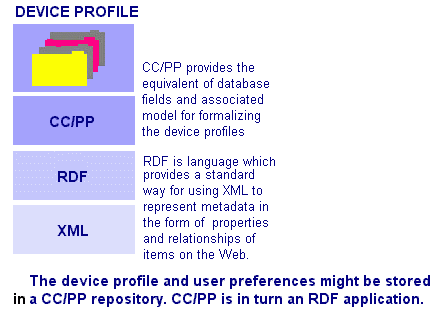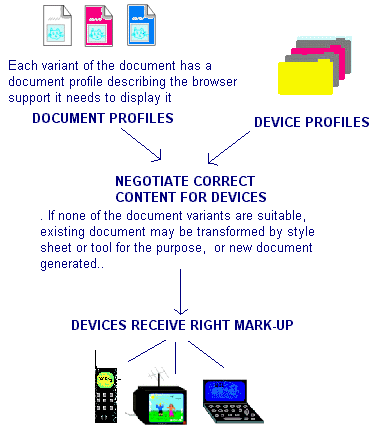

There are currently significant efforts invested to integrate Web technologies into various devices. Web services are becoming accessible from a wide range of devices including cellular phones, TV, digital cameras and in-car computers. Commercial products and services are deployed or planned based on specifications which take the adaptability of those devices into account. A possible threat is that those devices and services would not be interoperable with each other or with the existing Web. That would cause fragmentation of the Web and make device independent authoring hard and hence W3C's Device Independence Activity is working to ensure seamless Web access with various kinds of devices.
How can a server know that a mobile phone with a very small screen is requesting a Web page, rather than a pocket-sized computer asking for the same information?
The idea here is to store data about each device - and also the preferences of its user - as a device profile and to store device profiles as a kind of relational database located on a Web server. This has lead to Composite Capability/Preference Profiles (CC/PP).

The Composite Capability/Preference Profiles (CC/PP) is a user-side framework for content negotiation and was first issued as a W3C Note on 30th November, 1998. A Composite Capability/Preference Profile is a collection of information which describes the capabilities, hardware, system software and applications used by someone accessing the Web, as well as the particular preferences of the users themselves. The information collection includes a preferred language, sound on/off, images on/off, class of device (phone, PC, printer, etc.), screen size, available bandwidth, version of HTML supported, and so on.
Following that work, the W3C Note "CC/PP exchange protocol based on HTTP Extension Framework" described an application of the HTTP Extension Framework to exchange CC/PP information effectively over HTTP/1.1. This ultimately lead to the CC/PP Working Group.
The idea here is that, when a device makes a request over the Web for a Web page, a pointer to the device profile is appended to the request. In the case of a mobile phone, not only would the phone request a URI in the usual way, but it would also send a pointer in the form of a second URI to indicate where its device profile could be found.
The critical piece in the puzzle is that the "pointer" URI goes straight to the CC/PP database. CC/PP is written in Resource Description Framework (RDF), W3C's language for modelling metadata - descriptive information about items on the Web. Information encoded in RDF is always linked to Web addresses, for example: "the device with Web address http://www.deviceprofiles.example.com/abc1234 has the following profile..." etc. This means that by sending a URI for the device profile, all kinds of data about that device immediately becomes available.
The expectation is that different devices will make use of different modules of XHTML ; similarly they will support different modules of style sheets. For example, one device might use the basic XHTML text module and the style sheet voice module. Another device with a large screen might also allow the XHTML tables module.
The modularization of XHTML refers to the task of specifying well-defined sets of XHTML elements that can be combined and extended by document authors, document type architects, other XML standards specifications, and application and product designers to make it economically feasible for content developers to deliver content on a greater number and diversity of platforms.
Modularizing XHTML provides a means for product designers to specify which elements are supported by a device using standard building blocks and standard methods for specifying which building blocks are used. These modules serve as "points of conformance" for the content community. The content community can now target the installed base that supports a certain collection of modules, rather than worry about the installed base that supports this permutation of XHTML elements or that permutation of XHTML elements. The use of standards is critical for modularized XHTML to be successful on a large scale. It is not economically feasible for content developers to tailor content to each and every permutation of XHTML elements. By specifying a standard, either software processes can autonomously tailor content to a device, or the device can automatically load the software required to process a module.
So, XHTML is being designed as a series of modules associated with different functionality: text, tables, forms, images etc. Future Cascading Style Sheets (CSS) and Synchronized Multimedia Integration Language (SMIL) specifications will have the same modular construction. If a content provider wants information to be available for different devices, different versions of that content can be generated, for example using only the text modules, or perhaps using full graphics with scripting. Thus in its document profile, the document specifies the expected capabilities of the browser in terms of XHTML support, style sheet support and so on. During the process of matching, the document profile would be compared with the device profile, the best fit between the two would be discovered, and a suitable document would be generated or the best fitting variant would be selected.

So, as can be seen, together Composite Capability/Preference Profiles (CC/PP): Structure and Vocabularies and the Modularization of XHTML advancing to Proposed Recommendation status, progress towards the device independence of the future Web.
The W3C XML Query Working Group has released the first public Working Draft of XQuery: A Query Language for XML. The XQuery language is designed to be broadly applicable across all types of XML data sources from documents to databases and object repositories. Associated publications are:
Henry Thompson attends XML World Euro Edition, held 26-28 March, in Amsterdam, giving a keynote, XML - Knitting the Web Together, and a tutorial, Overview of the XML family of W3C Recommendations.
Five W3C Team members will give tutorials at the CeBIT 2001 world business fair and exhibition in Hannover, Germany: Thierry Michel, SMIL on 23 March; Daniel Dardailler, WAI on 24 March; Chris Lilley, SVG on 25 March; Bert Bos, Styling on 26 March; and Rigo Wenning, P3P on 27 March.
The submission deadline for Vendors Track proposals has been extended to: March 12, 2001. The Vendors Track provides WWW10 attendees the opportunity to hear directly from the companies whose commercial products shape the World Wide Web. Presentations will be technical, and focused on how vendors are integrating support for Internet technologies into their products. Presentations providing a technical vision for the future of the web will also be considered.
The deadline for Early-bird Registration is March 31, 2001 23:59 GMT-10. You can register online using the registration pages.
The number of Members has risen to 512 (13th March 2001). New Members this month are: